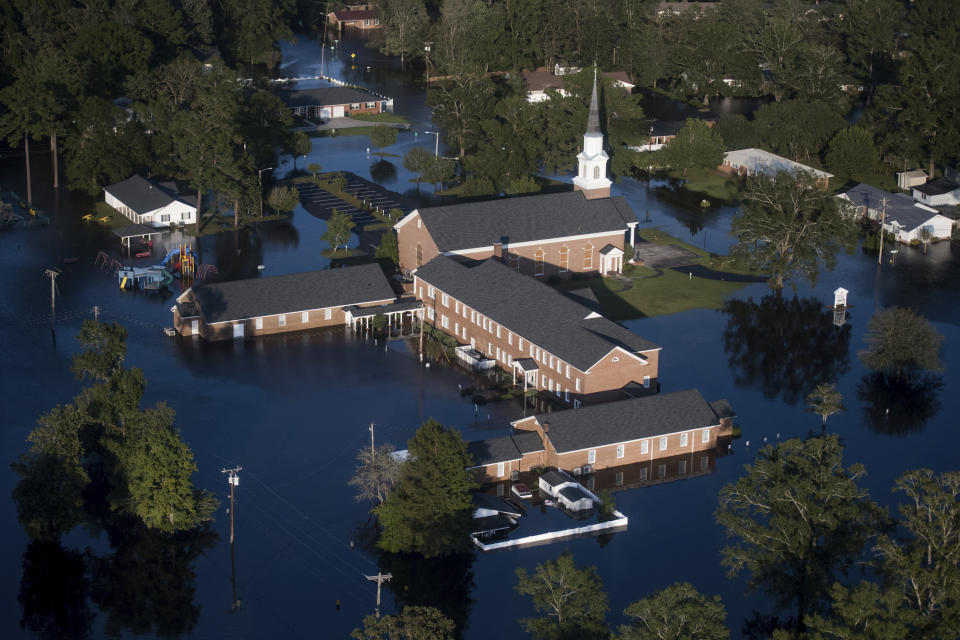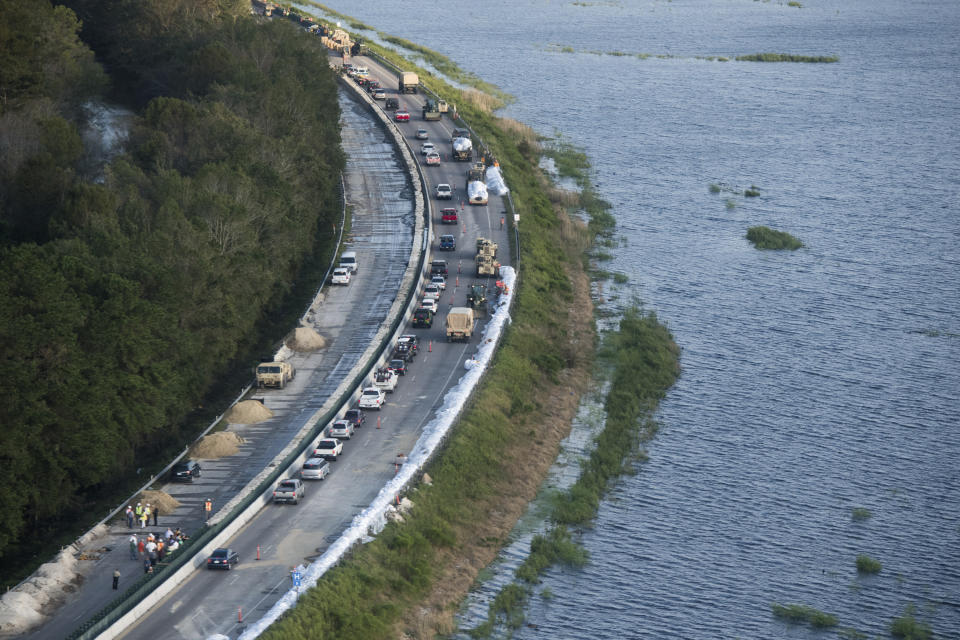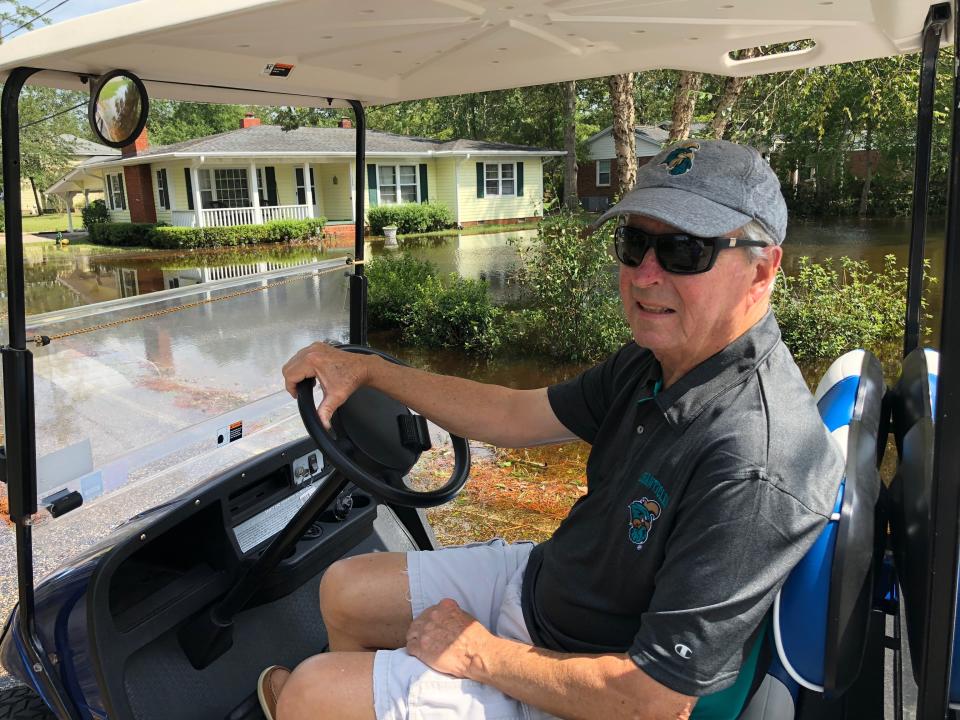Price of saving road to Myrtle Beach: Flooding nearby town?
CONWAY, S.C. (AP) — Two years ago, from Hurricane Matthew and in 1999, from Hurricane Floyd, floodwaters came close to entering Joe Holmes' house in South Carolina, but he dodged those bullets. Now, with Florence , he doesn't feel so lucky.
He worries the Waccamaw River will make its way into his Conway home because the state wants to save the main highway into Myrtle Beach, a more densely populated city and tourist destination, from going underwater.
Officials insist they must keep the road open, or hundreds of thousands of people would be isolated. So the state is building a higher wall on top of the sides of 1.5 miles (2.5 kilometers) of bridges and causeways, in its last stand on U.S. Highway 501.
Skeptical Conway residents fear this will push water into their neighborhoods, but officials say it won't affect any areas that weren't already doomed to flood — at least not in the models they've run.
"It's never been done before. They can't say for certain what it might do," Holmes said Monday, surveying flooded areas in his golf cart. "Why is that highway so important? Why can't they just fly food and fuel in? We've got a big airport."
Gov. Henry McMaster made his decision Saturday and never wavered.
"We must keep that road open," McMaster said. "That has been the plan from the very beginning, because there are only two good roads that go into there, and that's one of them.
It's the latest in a line of sometimes agonizing decisions by government officials weighing whether to alter floodwaters to save one area while potentially damaging others.
The U.S. Army Corps of Engineers in August 2017 released water from two dams that flooded expensive Houston neighborhoods because it feared the dams could fail and cause a catastrophic rush of water that could kill hundreds during Hurricane Harvey. There are some estimates the move could lead to billions of dollars in lawsuits.
In 1927, New Orleans businessmen persuaded officials to dynamite a levy on the Mississippi River to divert a flood making it way downstream. Tens of thousands of farms and homes of mostly poor residents were flooded, and they were given little compensation.
In South Carolina, it will be a slow-moving disaster as floodwaters from North Carolina continue downstream. In Nichols, some parts of the outskirts of the small town were already flooded. The Lumber River is approaching the bridge to the east of the town and rising along with the Little Pee Dee River to the west. Nichols was nearly destroyed by floodwaters after Hurricane Matthew two years ago.
In Cheraw and Wallace, the Great Pee Dee River that splits the cities was slowly falling. A helicopter with the governor flying over the area Monday spotted two men on the roof of a flooded car and had them rescued.
The focus of flooding in South Carolina would soon be the Waccamaw River — which winds through Conway, population 23,000 and home to Coastal Carolina University. It is already in a major flood. The river is predicted to be at 19.7 feet (6 meters) at noon Sunday — nearly 2 feet (61 centimeters) above the record set two years ago after Matthew — and still rising. It was just inches below the Matthew level in 1999 after Hurricane Floyd.
An estimated 1,000 homes will be flooded. Already, water is in some houses. It might not leave for up to a month, officials said.
Amid confusing explanations this past weekend about whether the effort to save the highway to Myrtle Beach was a dam, Conway Administrator Adam Emrick and the City Council agreed to threaten to sue to stop the project — they hadn't been guaranteed that the temporary barrier wouldn't cause more homes to flood.
But on Monday, the Department of Transportation gave a presentation and convinced most Conway officials that the barrier isn't a dam and water could continue to flow under the bridge.
"Because it is such a small distance and it isn't a full barrier, the damming effect will be negligible," Emrick said. "But if the river rises as forecasted, our understanding is those 944 homes will be at risk no matter what."
Mayor Barbara Blain-Bellamy also changed her mind.
"This is the better plan for all of us," she said. "Our ability to get goods and services depends on there being an open highway somewhere."
Some residents and City Council members aren't so sure.
Holmes remains worried, and he said the state bears some responsibility if his home floods.
"What they build is changing the river in some way," Holmes said.
"There's no doubt," Councilman Tom Anderson agreed. "They haven't done it before. Why do it now?"
___
This story has been corrected to show correct dates for hurricanes Matthew and Floyd in first paragraph. Matthew was in 2016, Floyd in 1999.
___
Follow Jeffrey Collins on Twitter at https://twitter.com/JSCollinsAP .
Read his work at https://apnews.com/search/jeffrey%20collins .
___
For the latest on Hurricane Florence, visit https://www.apnews.com/tag/Hurricanes .










